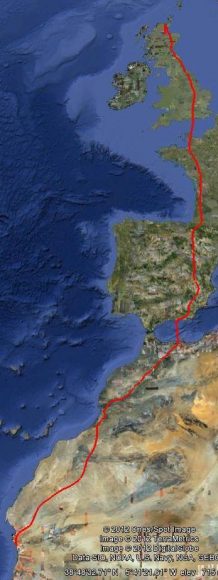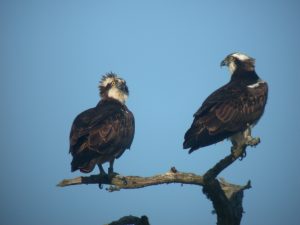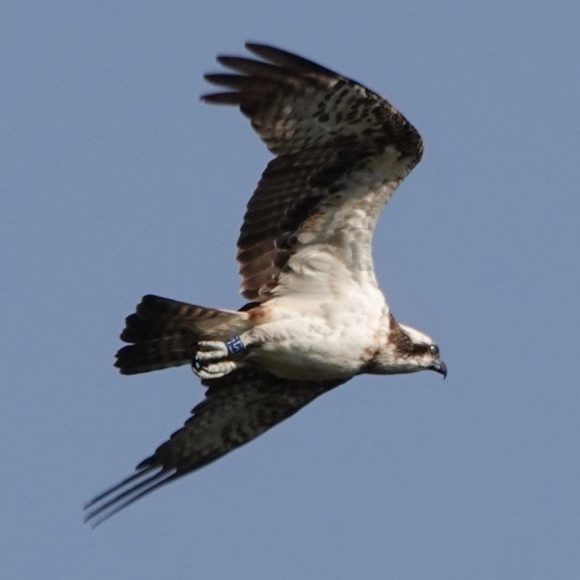Some ospreys remain in my mind for many years. There are old favourites like Logie, the first that I tracked with a new and highly accurate GPS satellite transmitter in 2007. Another was her neighbour, Morven. She tried to take over Logie’s nest in April 2008 but was quickly kicked out when Logie got back from Guinea Bissau. As a five-year-old local bird Morven spent the summer visiting osprey nesting places in the North of Scotland. On 9thJuly I live-caught her and fitted a transmitter when she was near the nest belonging to Beatrice – another of the Forres clan. Soon we learnt about her life. Instead of going south in late August she flew north to the Caithness trout lochs, not far north of the distinctive mountain named Morven. It’s a landmark across the Moray Firth from where I live near Forres. She was observed there by my old friend Stan Laybourne before migrating south. Winter quarters proved to be on the coast of Mauritania.

We satellite-tagged Morven as an adult in Moray in 2008.

Morven migrated to Mauritania after we tagged her in 2008. He transmitter to continued to provide data for a further five years.
Perseverance paid off because the following spring she bred with Logie’s old mate Talisman and reared one young. Logie had disappeared in September 2008 on autumn migration. Morven’s annual migration pattern was then established; after breeding she flew north each year to Caithness for a few weeks trout fishing and then migrated south to the Mauritanian coast. On the spring migration north she stopped off for a short break on the Villiviciosa estuary in North Spain, before the last leg to Moray. In 2011 she bred again at the same nest but with a new male, yellow HA, and reared 3 young, they reared one young in 2012 and three in 2013. But in 2014 her mate was killed by a new male, and they were also kicked out by a younger pair and moved to unused nest some miles away. Morven was too late to breed in 2014 but she and her new mate reared two young in 2015 and one in 2016. In March 2017 she was live-trapped at an artificial osprey nest on the Villiviciosa estuary by osprey biologist, Doriana Pando, and the defunct transmitter was removed.

Morven and her mate, Talisman.
Some ospreys were very delayed by bad weather in 2017 but not Morven, who gave up waiting for her mate and moved to join an old male at another nest in the Forres area, and there she reared three young. In 2018, she was at the Spanish estuary on 20thMarch and returned to incubate eggs, but the nesting attempt failed, possibly due to pine martens. She has not been seen since. 15 years of age she contributed much to osprey conservation. She nested in three different eyries with four different mates which is unusual for ospreys. Some of her young were translocated to the Basque reintroduction project and one in 2015 to start the Swiss project. We also satellite tagged her single young in 2012 and named him Stan, in memory of my Caithness birding friend, who had died. Sadly, we lost contact with Stan off the Cape Verde islands after an incredible nine day, 5000 kilometres migration over the Atlantic Ocean via the Canary Islands.
Importantly in 2017, one of her young, blue colour ring LS7, was translocated to Poole Harbour. LS7 was a young male, the first to fly from the hacking cages at Poole Harbour when we started the latest reintroduction project in partnership with Birds of Poole Harbour and Wildlife Windows. He was a winner, attacked by a peregrine on his first flight at 05.45am on 31stJuly 2017, he soon settled down to feed up from fresh fish supplied by the project team.

LS7 was the first of the birds to fly after release on 31st July (photo by Tim Mackrill)
He was the first to leave on migration on 25thAugust and his post-fledging period of 25 days was equal shortest of the eight young that year. On 22ndJanuary 2018 he was seen and identified on the Ile des Oiseaux by Adam Lene a ranger in the Sine Saloum National Park in Senegal. Both Tim and I have visited this fantastic sandy island off the mangrove swamps, it’s an osprey Mecca.

LS7 was seen at Ile des Oiseaux in Senegal on 22nd January 2018. Wintering birds – both adults and juveniles – often perch together at this osprey Mecca (photo by John Wright).
It’s a long two-year’s wait to see which ospreys have survived their migrations and extended stays in West Africa and then return to the UK. LS7 was our first return as a two-year old when he was seen and identified by Paul Morton on 12thJune. Almost immediately he met the well-known female, blue CJ7, which fledged from a nest at Rutland Water in 2015. She has been a regular at Poole Harbour and this spring was building up nests around the harbour and keeping an eye out for a mate. Too late to breed in 2019, their activity together bodes well for the future. These recovery projects rely so often on small numbers of winners, which have survived their first years learning the migration routes and wintering sites, and the associated dangers of bad weather and predators.
In a few week’s time the next group of young Scottish ospreys will be in the Poole Harbour hacking-cages ready for release from the end of July. I guess both LS7 and CJ7 will take an interest in the new cohort of ospreys and hopefully they will survive to start a breeding population in the south coast estuaries. Then we can say the mullet-hawk is truly back. If LS7 is the pioneer of that exciting future then he will be following in his mother’s illustrious life.

LS7 returned to Poole Harbour on 12th June (photo by Alison Copland)


















